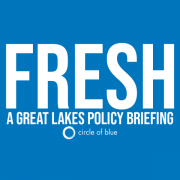FRESH, July 12, 2022: Michigan Agency Launches Mercury Monitoring Program
July 12, 2022
Fresh is a biweekly newsletter from Circle of Blue that unpacks the biggest international, state, and local policy news stories facing the Great Lakes region today. Sign up for Fresh: A Great Lakes Policy Briefing, straight to your inbox, every other Tuesday.
— Laura Gersony, Fresh Editor
This Week’s Watersheds
- A Michigan agency announces a new program to monitor mercury contamination.
- Millions of Great Lakes residents eat more fish than public health officials recommend, a study finds.
- The Ohio EPA spars with federal agencies over pollution control in Lake Erie.
- The U.S. Army Corps of Engineers awards a $1 billion contract to overhaul the lock system that connects the Great Lakes.
Three years after record floods hit Lake Ontario’s shoreline, another round of federal relief funds may be on the way.
“I thought [my house] would be totaled, so I just took it upon myself. I was turned down for financing by the agency that was running the program for the state, and I paid for it by myself.”— Mike Shults, resident of Sodus Point, a New York town that flooded twice in recent years.Sen. Chuck Schumer is asking the Federal Emergency Management Agency for more flood prevention funds for Lake Ontario towns, WHAM reports. Unusually wet conditions lifted the lake to record levels in 2017 and 2019, damaging property and critical infrastructure across the St. Lawrence River basin. Initial relief funding was stretched thin, forcing many flood victims to pay for costly repairs out of pocket. Schumer announced last week that the state has secured an additional $500 million from FEMA to help homes and businesses rebuild and prepare for future floods. Leaders expect funds to be disbursed starting in early 2023.
- Why it matters: Global climate change has made extreme rainfall events more likely across the Great Lakes region. Last year for the Great Lakes News Collaborative, Michigan Radio covered how climate change propels drastic swings in Lake Superior’s water levels, surface temperatures, and wind speeds.
Fresh from the Great Lakes News Collaborative

- Indiana might be changing its tone toward wind energy — Great Lakes Now
- New laws make it easier for communities to access state financing for water infrastructure — Michigan Radio
- A smaller than average amount of harmful cyanobacterial blooms forecasted for Lake Erie, but some hot spots possible — Michigan Radio
As the nation prepares to pour hundreds of billions of dollars into rescuing water systems, The Great Lakes News Collaborative investigates the true cost of water in Michigan. Catch up on this 10-part series here.
The Great Lakes News Collaborative includes Bridge Michigan; Circle of Blue; Great Lakes Now at Detroit Public Television; and Michigan Radio, Michigan’s NPR News Leader. We work together to produce news and information about the impact of climate change, pollution, and aging infrastructure on the Great Lakes and drinking water. This independent journalism is supported by the Charles Stewart Mott Foundation. Find all the work here.

Michigan To Track Mercury Vapor Contamination
The Michigan Department of Environment, Great Lakes, and Energy is launching a new database to monitor mercury contamination, the Detroit News reports. Mercury, a toxic byproduct of certain industrial processes, may have contaminated over 24,000 sites across the state, according to an agency report released last year. At present, the agency rigorously monitors only one-third of these sites. Officials are now soliciting high-quality data for soil, surface water, and soil vapor.
In the News
PUBLIC HEALTH: A new study found that more than 5 million people in the Great Lakes region regularly consume more fish than public health agencies recommend, according to Great Lakes Echo. Due to water contamination, public health guidelines advise limiting consumption to two fish, or 12 ounces, per week. The study found that only about half of Great Lakes residents are aware of such advisories. Eating too much contaminated fish can cause toxic chemicals — mercury, PFAS, and PCBs among them — to build up in the human body in a process known as bioaccumulation.
PERMITTING: The Ohio EPA and the U.S. EPA disagree over how much phosphorus a wastewater treatment plant in Euclid may discharge into Lake Erie, cleveland.com reports. The state agency moved to renew the plant’s permit, allowing 1 milligram per liter of effluent waste per month. The U.S. EPA recommended a significantly stricter limit of 0.007 milligrams per liter, offering 0.5 milligrams per liter as a compromise. Ohio regulators insist that the stricter standards would have no meaningful impact on the lake and would hike costs for ratepayers, calling the proposed rule a “concerning precedent” for similar cases across the state.
- Why it matters: Lake Erie’s annual toxic algae blooms are fed by runoff from agricultural land. In 2020 for the Great Lakes News Collaborative, Great Lakes Now investigated how large-scale dairy and animal operations threaten the waters.
Looking Ahead
SHIPPING: The U.S. Army Corps of Engineers is proceeding with a $1 billion contract to overhaul the lock system that connects the Great Lakes, MLive reports. Known as the “Linchpin of the Great Lakes,” the Soo Locks system will soon include a new chamber the length of four football fields. The project will be completed in 2030.
Other News
- U.S. Steel invests $150 million in a fuel production plant in Minnesota’s Iron Range.
- In Wisconsin, potential blackouts spark debate about the role of fossil fuels in the state’s energy grid.
- A court throws out the charges against Michigan’s former governor for his role in the Flint water crisis.
- The University of Michigan receives $53 million to continue its work on Great Lakes sustainability issues.
Laura Gersony covers water policy, infrastructure, and energy for Circle of Blue. She also writes FRESH, Circle of Blue’s biweekly digest of Great Lakes policy news, and HotSpots H2O, a monthly column about the regions and populations most at-risk for water-related hazards and conflict. She is an Environmental Studies and Political Science major at the University of Chicago and an avid Lake Michigan swimmer.








Leave a Reply
Want to join the discussion?Feel free to contribute!